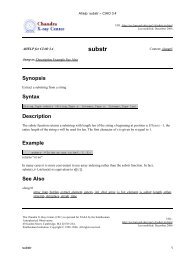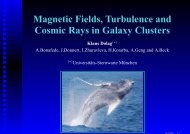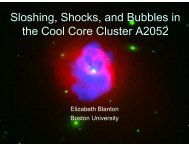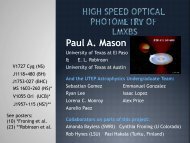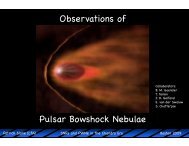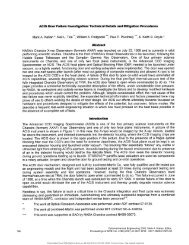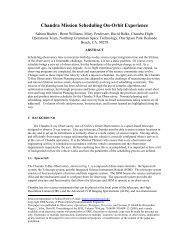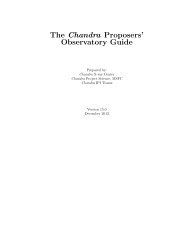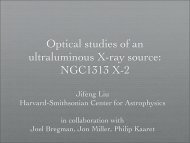PDF Version - Chandra X-Ray Observatory (CXC)
PDF Version - Chandra X-Ray Observatory (CXC)
PDF Version - Chandra X-Ray Observatory (CXC)
Create successful ePaper yourself
Turn your PDF publications into a flip-book with our unique Google optimized e-Paper software.
4<br />
<strong>CXC</strong> Newsletter<br />
follow features observed in the Hubble [OIII] image.<br />
The HRMA’s PSF (half-power diameter HPD = 0.6” at E ∼ 1.5 keV; see the <strong>Chandra</strong> POG) is under-sampled by<br />
the ACIS CCD pixels (0.492” × 0.492”); the ACIS native pixel image of the central region of NGC4151 in the soft energy<br />
interval relatively less affected by nuclear pileup, is shown in Fig. 2a. However, the real sampling of the PSF is better than<br />
that provided by the ACIS detector pixel, because of the dithering pattern of the <strong>Chandra</strong> telescope. We took advantage<br />
of this telescope dithering by using a finer pixel size (0.0625”, ~1/8 of the native ACIS pixel size) when extracting the images<br />
(see full explanation 10 ). This sub-pixel binning approach has been adopted previously in imaging studies of X-ray jets<br />
pushing for the highest spatial resolution 11 . The ACIS images with sub-pixel binning (see Fig. 2b) reveal curvy extensions<br />
2” away from the nucleus (labeled as “C” and “D”), which are not discernible in the native pixel soft ACIS image, but are<br />
present in both [OIII] and the HRC image.<br />
Fig. 2 - a) ACIS image<br />
using the native ACIS<br />
pixel; b) Same data, subpixel<br />
binned (1/8 of ACIS<br />
pixel), and smoothed<br />
with an FWHM = 0”.25<br />
Gaussian kernel for better<br />
visualization of faint<br />
extended features.<br />
By comparing the HRC data with the ACIS sub-pixel image, we demonstrated that we could recover the full<br />
resolution of the <strong>Chandra</strong> mirror even in the spatially under-sampled ACIS data. Sub-pixel imaging allows us to expand<br />
ultimate high-resolution studies to other active galaxies.<br />
Starting with our pilot study of NGC4151 (PI:<br />
Fabbiano), we are now pursuing a program of deep subarc-second<br />
resolution spatial/spectral studies of the circum-nuclear<br />
regions of a sample of nearby AGNs with<br />
extended optical emission line regions (CHEERS, PI: J.<br />
Wang). We can study details of the circum-nuclear regions<br />
down to ~100 pc, spatial scales commensurable<br />
with those reached by high-resolution optical and radio<br />
telescopes. One of these galaxies is NGC3393, a prominent<br />
bulge spiral at a distance of ~50 Mpc, with a highly<br />
absorbed (Compton thick 12 ) AGN and an extended, spiral<br />
like circum-nuclear narrow emission line region (Fig. 3).<br />
NGC3393 had been previously observed with<br />
<strong>Chandra</strong> for 30 ks with ACIS 13 to study the Compton thick<br />
AGN. This work had reported a nuclear source X-ray spectrum<br />
with a featureless continuum and a prominent 6.4<br />
keV Fe-K line. We observed NGC3393 for an additional<br />
70 ks as part of CHEERS. The extended X-ray emission,<br />
associated with the optical line emission, is clearly seen<br />
in the image (see blue insert in Fig. 3, showing the total<br />
screened combined exposure of ~90 ks.) We detected a total<br />
of 279±16 counts (3–8 keV) from the nuclear source<br />
in the combined exposure, with an ACIS spectrum—also<br />
shown in Fig. 3—consistent with that previously reported<br />
13 .<br />
Junfeng and I were looking at the combined deep<br />
X-ray image using DS9, zooming in to look at the central<br />
AGN, when we had a surprise: the hard-band emission<br />
(3–8 keV), which should not be affected by softer photo-<br />
or shock-ionized circum-nuclear components, did not<br />
look point-like. Its spectrum, however, was typical of a<br />
Compton-thick AGN (see Fig. 3). The X-ray image, with<br />
¼ pixel binning, is shown in Fig. 4. The X-ray centroid<br />
agrees with the emission line central source position (diamond),<br />
but the radio position is displaced to the SW, towards<br />
the elongation of the X-ray source.<br />
This spatial extension of the hard nuclear emission<br />
was puzzling enough to warrant further experimen-



